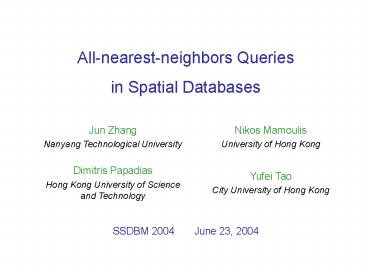Allnearestneighbors Queries in Spatial Databases - PowerPoint PPT Presentation
1 / 17
Title:
Allnearestneighbors Queries in Spatial Databases
Description:
If there is an object ai in A whose NNdist(ai, B) is large, all the entry pairs with distance smaller than NNdist(ai, B) are required to be visited ... – PowerPoint PPT presentation
Number of Views:34
Avg rating:3.0/5.0
Title: Allnearestneighbors Queries in Spatial Databases
1
All-nearest-neighbors Queries in Spatial
Databases
SSDBM 2004 June 23, 2004
2
All-nearest-neighbors Queries
- All-nearest-neighbors queries Given two
multidimensional dataset A and B, for each object
in A, find its nearest neighbor in B - All-nearest neighbors query application
Geographic Information Systems (GIS), Data
Mining, etc.
3
R-trees and NN Search
- R-trees Gut84 multi-dimensional index
structure - Nearest neighbor (NN) queries
- Depth-first NN query processing RKV95
- Best-first NN query processing HS99
incremental, optimal I/O cost - Closest pair queries CMTV00 find the closest
object pairs from A and B
4
All-nearest-neighbors Queries with CP
- All-NN query processing with CP queries HS98,
CMTV01 - Closest pair query is performed on dataset A and
B - A bitmap S0 of size A is used to indicate for
each point in A, whether its nearest neighbor has
been found - If an object pair ltai, bjgt is the first for ai,
then bj is the NN for ai - The algorithm terminates when S0ai 1 for all
ai ? A - The disadvantage of ANN with CP
- If there is an object ai in A whose NNdist(ai, B)
is large, all the entry pairs with distance
smaller than NNdist(ai, B) are required to be
visited - Inefficient
5
Indexed-based ANN Multiple NN
- All-nearest-neighbors query processing with
multiple nearest neighbor queries (assume dataset
B is indexed) - Perform A NN queries (one for each object in A)
on R-tree RB - The order of the NN queries is important if there
exists an LRU buffer - If A is not indexed, we sort the objects using a
space filling curve (e.g., Hilbert) and visit
them in this order - If A is indexed, we traverse the R-tree RA
following the Hilbert order of the entry (with
respect to the center of the entry MBR) - Some observations about multiple NN
- The dominant cost is the CPU cost
6
Indexed-based ANN Batched NN
- All-nearest-neighbors query processing with
batched nearest neighbor (BNN) queries - Retrieves the nearest neighbors for a group of
objects at a time - Reduce the number of distance computation
- Apply optimizations like planesweep
- Several criteria for BNN grouping
- The number of points in each group should be
maximized - The MBR of each group should be minimized
- Each group should be small enough to fit in memory
7
Forming Groups in Batched NN
- Take the objects one by one until any of the
following constraints is violated - The number of objects in the group is smaller
than max_num - The area of the grouping MBR is smaller than
max_area
- Determine max_num and max_area
- max_num is determined by the available memory
- max_area is related to the density of the dataset
B in the area - Perform a NN search for the first object in the
group - Estimate the max_area as the average area of the
leaf nodes of B visited in the search
8
Batched NN
- Take the objects one by one into a group,
maximizing locality - If A is not indexed
- Sort the objects in A by their Hilbert value
- If A is indexed
- Start from the root, follow entries recursively
accordingly to the Hilbert value of their
centroids - Find the NN for the objects in the group
- Use NN algorithm (with respect to the MBR of the
objects) - Keep the current nearest neighbor for each object
- The algorithm terminates when no better result is
possible for all the objects
9
Non-indexed-based ANN a Hash Approach
- All-nearest-neighbors query processing with
hashing (assume neither dataset A nor B is
indexed)
- An observation most of the objects are in the
same partition as their nearest neighbors
10
Hash ANN Query Processing
- Load the corresponding buckets and find the NN in
the bucket - For the border objects, put them to a local
pending set and a global pending list - When a bucket is loaded, process the objects in
the pending set - A 2nd pass might be required to handle buckets
with non-empty pending set
11
Optimization of Hash ANN
- The goal minimize the number of page accesses
required by the 2nd pass of the algorithm - Define a good tiling and a good scheduling of
partitions
12
Experiment Settings
- Simulator written in C
- CPU Pentium III 733 MHz
- Page size 4KByte
- LRU Buffer 512KByte
- Dataset United States
13
Experiments Indexed Datasets
14
Experiments Non-indexed Datasets
15
Experiments Self ANN
16
Conclusions
- Existing closest pair techniques is not suitable
for all-nearest-neighbors queries - Based on whether dataset A and B is indexed, we
developed different ANN processing methods - For indexed datasets, batched nearest neighbor
(BNN) is more efficient than multiple nearest
neighbor (MNN) - For large non-indexed datasets, hash-based all
nearest neighbor (HNN) outperforms BNN build
the tree on the fly - Future work (1) extend to high dimensional
space (2) extend to
all-k-nearest-neighbors
17
- Thank you!
- Questions































